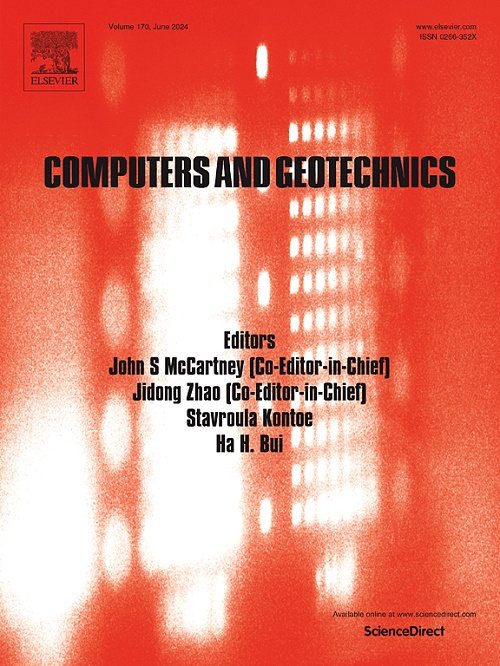Enhanced elastoplasticity-based frictional-collisional model for solid–fluid phase transition of granular media
IF 5.3
1区 工程技术
Q1 COMPUTER SCIENCE, INTERDISCIPLINARY APPLICATIONS
引用次数: 0
Abstract
Accurately describing the solid-like and fluid-like behaviors of granular media is crucial in geotechnical engineering. While the unified frictional-collisional model, integrating rate-independent frictional and rate-dependent collisional stresses, is widely used for solid–fluid phase transitions, an effective model is still under investigation, and comprehensive analyses are lacking. This study addresses these gaps by developing an enhanced elastoplasticity-based frictional-collisional model. The frictional stress is modeled using a critical-state-based elastoplasticity approach, and the collisional stress is formulated through an enhanced kinetic theory incorporating particle stiffness. Subsequently, comprehensive element simulations are conducted to explore the effects of concentration, particle stiffness, and strain rate paths on the model. The proposed model’s effectiveness is also validated against experimental data. Finally, a detailed comparison with the typical μ(I) rheology model and a state-equation-based phase transition model is conducted. Our analyses show that the developed model effectively captures strain rate path and particle stiffness through the collisional stress component, while concentration-dependent characteristics are captured through both frictional and collisional stress components. Through comparative analyses, we also found that both the state-equation-based and elastoplasticity-based models depict solid-like behavior and replicate the rheology of granular media in a fluid-like state, similar to the μ(I) model. However, they differ in implementing critical state theory: the state-equation-based model acts as a partial-range phase transition model, describing stress evolution from the critical state to the fluid-like state, while the proposed elastoplasticity-based model serves as a full-range phase transition model, covering stress evolution from the initial to the fluid-like state.
求助全文
约1分钟内获得全文
求助全文
来源期刊

Computers and Geotechnics
地学-地球科学综合
CiteScore
9.10
自引率
15.10%
发文量
438
审稿时长
45 days
期刊介绍:
The use of computers is firmly established in geotechnical engineering and continues to grow rapidly in both engineering practice and academe. The development of advanced numerical techniques and constitutive modeling, in conjunction with rapid developments in computer hardware, enables problems to be tackled that were unthinkable even a few years ago. Computers and Geotechnics provides an up-to-date reference for engineers and researchers engaged in computer aided analysis and research in geotechnical engineering. The journal is intended for an expeditious dissemination of advanced computer applications across a broad range of geotechnical topics. Contributions on advances in numerical algorithms, computer implementation of new constitutive models and probabilistic methods are especially encouraged.
 求助内容:
求助内容: 应助结果提醒方式:
应助结果提醒方式:


